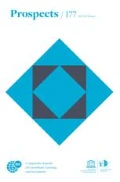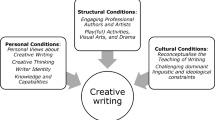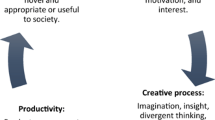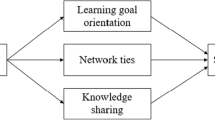Abstract
The 2006 UNESCO conference Building Creative Competencies for the 21 st Century had international participants and a global reach. The Director-General’s proclamation that “Creativity is our hope” captured the essence of the proceedings and participants saw the focus on creativity as offering solutions to global problems. However, educators tend not to understand creativity appropriately or to value it strongly—and they tend to see it only through Western eyes. Only by considering other cultural views will we gain insights that can inform educational practice in the 21st-century global community. This article discusses some recent studies of creativity, reflecting the growing global interest in it and comparing that interest with established Western perspectives. A more comprehensive, international perspective might support a press for fostering creative thinking in schools and inform practices in our increasingly interconnected world; however, teacher training must introduce teachers to the diversity of views and the expectations of local people.
Similar content being viewed by others
References
Amabile, T. M. (1983). The social psychology of creativity. New York: Springer.
Amabile, T. M. (1996). Creativity in context. Boulder: Westview.
Anderson, L. W., & Krathwohl, D. R. (Eds.) (2001). A taxonomy for learning, teaching and assessing. New York: Longman.
Azzam, A. M. (2009). Why creativity now? A conversation with Sir Ken Robinson. Educational Leadership, 67(1), 22–26.
Baer, J., & Kaufman, J. C. (2008). Gender differences in creativity. Journal of Creative Behavior, 42(2), 75–105.
Baer, J., & McKool, S. S. (2009). Assessing creativity using the consensual assessment technique. In C. Schreiner (Ed.), Handbook of research on assessment technologies, methods, and applications in higher education (pp. 65–77). Hershey, PA: IGI Global.
Banaji, S. (2008). Creativity: Exploring the rhetorics and the realities. In R. Willet, M. Robinson, & J. Marsh (Eds.), Play, creativity and digital cultures (pp. 147–165). London: Routledge. http://eprints.lse.ac.uk/27362/.
Bandarin, F. (2011). The creative power of cities. City, Culture and Society, 2, 121–122.
Beghetto, R. A. (2007). Does creativity have a place in classroom discussions? Teachers’ response preferences. Thinking Skills and Creativity, 2(1), 1–9.
Bell, D., & Jayne, M. (2010). The creative countryside: Policy and practice in the UK rural cultural economy. Journal of Rural Studies, 26, 209–218.
Besançon, M., & Lubart, T. (2008). Differences in the development of creative competencies of children schooled in diverse learning environments. Learning and Individual Differences, 18, 381–389.
Besemer, S. P., & O’Quin, K. (1987). Creative product analysis. In S. G. Isaksen (Ed.), Frontiers of creativity research (pp. 341–357). Buffalo: Bearly.
Bloom, B. S. (Ed.) (1956). Taxonomy of educational objectives: The classification of educational goals. Handbook 1: Cognitive domain. New York: McKay.
Bobel, I. (2012). Jugaad: A new innovation market. Journal of Business and Financial Affairs, 1(4), 1.
Boden, M. A. (1994). Precis of the creative mind: Myths and mechanisms. Brain and Behavioural Science, 17, 519–531.
Boden, M. A. (2004). The creative mind: Myths and mechanisms. London: Routledge.
Bowkett, S. (2007). 100+ ideas for teaching creativity. London: Continuum.
Burnard, P. (2006). Editorial: Reflecting on the creativity agenda in education. Cambridge Journal of Education, 36(3), 313–318.
Burnard, P., & White, J. (2008). Creativity and performativity: Counterpoints in British and Australian education. British Educational Research Journal, 34(5), 667–682.
Byrne, C., MacDonald, R., & Carlton, L. (2003). Assessing creativity in musical compositions: Flow as an assessment tool. British Journal of Music Education, 20(3), 277–290.
Carruthers, P. (2002). Human creativity. British Journal of the Philosophy of Science, 53, 225–249.
Cheng, V. M. Y. (2010). Tensions and dilemmas of teachers in creativity reform in a Chinese context. Thinking Skills and Creativity, 5, 120–137.
Chien, C.-Y., & Hui, A. N. N. (2010). Creativity in early childhood education: Teachers’ perceptions in three Chinese societies. Thinking Skills and Creativity, 5, 49–60.
Chiu, C.-Y., & Kwan, L. Y.-Y. (2010). Culture and creativity. Management and Organization Review, 6(3), 447–461.
Compton, A. (2007). What does creativity mean in English education? Education 3–13, 35(2), 109–116.
Cowdroy, R., & Williams, A. (2007). Assessing creativity in the creative arts. Art, Design and Communication in Higher Education, 5(2), 97–117.
Craft, A. (2002). Creativity and early years education. London: Continuum.
Craft, A. (2003). The limits to creativity in education. British Journal of Educational Studies, 51(2), 113–127.
Craft, A. (2006). Fostering creativity with wisdom. Cambridge Journal of Education, 36, 337–350.
Craft, A. (2010). Possibility thinking and wise creativity: Educational futures in England? In R. A. Beghetto & J. C. Kaufman (Eds.), Nurturing creativity in the classroom (pp. 289–312). Cambridge: Cambridge University Press.
Creative Partnerships (2004). Catalyst: This is how education should be, isn’t it? London: Creative Partnerships.
Cremin, T., Burnard, P., & Craft, A. (2006). Pedagogy and possibility thinking in the early years. International Journal of Thinking Skills and Creativity, 1, 108–119.
Csikszentmihalyi, M. (1996). Creativity: Flow and the psychology of discovery and invention. New York: Harper Collins.
Eason, R., Giannangelo, D. M., & Franceshini, L. A. (2009). A look at creativity in public and private schools. Thinking Skills and Creativity, 4, 130–137.
Eckhoff, A., & Urbach, J. (2008). Understanding imaginative thinking during childhood. Early Childhood Education Journal, 36, 179–185.
Erez, M., & Nouri, R. (2010). Creativity: The influence of cultural, social, and work contexts. Management and Organization Review, 6(3), 351–370.
Faggian, A., Partridge, M., & Malecki, E. (2010). Creating an environment for economic growth: Human capital, creativity, entrepreneurship in the USA. Paper presented at the North American Regional Science Association meeting in Denver Colorado, 10–13 November 2010.
Ferrari, A., Cachia, R., & Punie, Y. (2009). Innovation and creativity in education and training in EU member states: Fostering creative learning and supporting innovative teaching. Literature review on innovation and creativity in E&T in the EU member states (ICEAC). JRC-ITPS technical note #52374. Seville: European Commission Joint Research Centre/Institute for Prospective Technological Studies. http://www.jrc.ec.europa.eu/.
Fleith, D. (2011). Creativity in the Brazilian culture. Online Readings in Psychology and Culture, 4(3). doi:10.9707/2307-0919.1037.
Fredrickson, B. L. (2004). The broaden-and-build theory of positive emotions. Philosophical Transactions of the Royal Society: Biological Sciences, 359, 1367–1377.
Fredrickson, B. L., & Branigan, C. (2005). Positive emotions broaden the scope of attention and thought-action repertoires. Cognition and Emotion, 19(3), 313–332.
Fryer, M. (1996). Creative teaching and learning. London: Paul Chapman.
Gardner, H. (1993). Creating minds. New York: Basic Books.
Glăveanu, V. P. (2011). Children and creativity: A most (un)likely pair. Thinking Skills and Creativity, 6, 122–131.
Haddon, F. A., & Lytton, H. (1968). Teaching approaches and the development of divergent thinking abilities in primary schools. British Journal of Educational Psychology, 38, 171–180.
Haylock, D. W. (1987). A framework for assessing mathematical creativity in schoolchildren. Educational Studies in Mathematics, 18, 59–74.
Ho, K. C. (2009). The neighbourhood in the creative economy: Policy, practice and place in Singapore. Urban Studies, 5&6, 1187–1201.
Hui, A. N. N., & Yuen, C. M. (2010). The blossoming of creativity in education in Asia: Changing views and challenging practices. Thinking Skills and Creativity, 5, 155–158.
Hunsaker, S. L., & Callahan, C. M. (1995). Creativity and giftedness: Published instruments uses and abuses. Gifted Child Quarterly, 39, 110–114.
Jeffrey, B., & Craft, A. (2004). Teaching creatively and teaching for creativity: Distinctions and relationships. Educational Studies, 30(1), 77–87.
Kampylis, P., Berki, E., & Saarilouma, P. (2009). In-service and prospective teachers’ conceptions of creativity. Thinking Skills and Creativity, 4, 15–29.
Kaufman, J. C., Baer, J., Agars, M. D., & Loomis, D. (2010). Creativity stereotypes and the consensual assessment technique. Creativity Research Journal, 22(2), 200–205.
Kharkhurin, A. V., & Motelleebi, S. N. S. (2005). The impact of culture on the creative potential of American, Russian, and Iranian college students. Creativity Research Journal, 20(4), 404–411.
Kim, K. H. (2008). Underachievement and creativity: Are gifted underachievers highly creative? Creativity Research Journal, 20(2), 234–242.
Kimbell, R. (2000). Creativity in crisis. The Journal of Design and Technology Education, 5(3), 206–211.
Kind, P. M., & Kind, V. (2007). Creativity in science education: Perspectives and challenges for developing school science. Studies in Science Education, 43, 1–37.
Lin, Y.-S. (2010). Drama and possibility thinking: Taiwanese pupils’ perspectives regarding creative pedagogy in drama. Thinking Skills and Creativity, 5, 108–119.
Lin, Y.-S. (2011). Fostering creativity through education: A conceptual framework of creative pedagogy. Creative Education, 2(3), 149–155.
Loveless, A. M. (2002). Literature review in creativity, new technologies and learning. Futurelab Series Report 4. Bristol: Futurelab. http://hal.inria.fr/docs/00/19/04/39/PDF/loveless-a-2002-r4.pdf.
Maker, C. J., Sonmi, J., & Muammar, O. M. (2008). Development of creativity. Learning and Individual Differences, 18, 402–417.
McWilliam, E., & Dawson, S. (2008). Teaching for creativity: Towards sustainable and replicable pedagogical practice. Higher Education, 56, 633–643.
McWilliam, E., & Haukka, S. (2008). Educating the creative workforce: New directions for twenty-first century schooling. British Educational Research Journal, 34(5), 651–666.
Moore, K. D. (2008). Effective instructional strategies from theory to practice. London: Sage.
Morris, M. W., & Leung, K. (2010). Creativity east and west. Management and Organization Review, 6(3), 313–327.
NACCCE [National Advisory Committee on Creative and Cultural Education] (1999). All our futures: Creativity, culture and education. London: Department for Education and Employment.
Newton, D. P. (2010). Assessing the creativity of scientific explanations in elementary science: An insider-outsider view of intuitive assessment in the hypothesis space. Research in Science and Technological Education, 28(3), 187–201.
Newton, D. P. (2012a). Recognizing creativity. In L. D. Newton (Ed.), Creativity for a new curriculum (pp. 108–119). London: Fulton.
Newton, D. P. (2012b). Teaching for understanding (2nd ed.). London: Routledge.
Newton, D. P. (2013). Moods, emotions and creative thinking. Thinking Skills and Creativity, 8, 34–44.
Newton, D. P. (2014). Thinking with feeling: Fostering productive thought in the classroom. London: Routledge.
Newton, D. P., & Newton, L. D. (2009). Some student teachers’ conceptions of creativity in school science. Research in Science and Technological Education, 27(1), 45–60.
Newton, L. D. (Ed.) (2012c). Creativity for a new curriculum: 5–11. London: Routledge/David Fulton.
Newton, L. D., & Newton, D. P. (2010). What teachers see as creative incidents in elementary science lessons. International Journal of Science Education, 32(1), 1989–2005.
Niu, W., & Kaufman, J. C. (2013). Creativity of Chinese and American cultures. Journal of Creative Behavior, 47(1), 77–87.
Omenyi, A. S., Ngozi, A., & Odimegwu, C. O. (2009). An assessment of the climate for creativity in secondary schools in Akwa South Local Government Area. Paper presented at the National Conference for Educational Administration and Planning (NAEAP) on Managing Inventions in the Nigerian Educational System, Women’s Development Centre, Awka, Anambra State, Nigeria, 22–26 September 2009.
Oral, G. (2006). Creativity of Turkish prospective teachers. Creativity Research Journal, 18, 65–73.
Paletz, S. B. F., & Peng, K. (2008). Implicit theories about creativity across cultures. Journal of Cross-Cultural Psychology, 39(3), 286–302.
Pedersen, E. L., & Burton, K. L. (2009). A concept analysis of creativity: Uses of creativity in selected design journals. Journal of Interior Design, 35(1), 15–32.
Pfiffer, D. (2012). Can creativity be measured? Thinking Skills and Creativity, 7, 258–264.
Phan, P., Zhou, J., & Abrahamson, E. (2010). Creativity, innovation, and entrepreneurship in China. Management and Organization Review, 6(2), 175–194.
QCA [Qualifications and Curriculum Authority] (2004). Creativity: Find it, promote it!. Sudbury: QCA Publications.
Radjou, N., Prabhu, J., & Ahuja, S. (2012). Jugaad innovation. New York: Jossey-Bass.
Richards, R. (1993). Everyday creativity. Psychological Inquiry, 4(3), 212–217.
Rowlands, S. (2011). Discussion article: Disciplinary boundaries for creativity. Creative Education, 2(1), 47–55.
Runco, M. A. (2008). Creativity and education. New Horizons in Education, 56(1), 96–104.
Shaheen, R. (2010). Creativity and education. Creative Education, 1(3), 166–169.
Shaw, M. P. (1989). The eureka process. Creativity Research Journal, 2, 286–298.
Sheikh, F. A. (2012). Jugaad innovation. African Journal of Science, Technology, Innovation and Development, 4(4), 294–297.
Siegesmund, R. (1998). Why do we teach art today? Studies in Art Education, 39(3), 197–214.
Silvia, P. J., Wigert, B., Reitner-Palmon, R., & Kaufman, J. C. (2011). Assessing creativity with self-report scales. Psychology of Aesthetics, Creativity, and the Arts. doi:10.1037/a0024071.
Silvia, P. J., Winterstein, B. P., Willse, J. T., Barona, C. M., Cram, J. T., Hess, K. I., et al. (2008). Assessing creativity with divergent thinking tasks. Psychology of Aesthetics, Creativity, and the Arts, 2(2), 68–85.
Singh, M., & Singh, V. J. (2012). Where there is Jugaad, there is a way. International Journal of Electronic Engineering, 4(2), 187–189.
Singh, R. (2012). Jugaad: From ‘making do’ and ‘quick fix’ to an innovative, sustainable and low-cost survival at the bottom of the pyramid. International Journal of Rural Management, 8(1–2), 87–105.
Torrance, E. P. (1966). The Torrance tests of creative thinking-norms. Technical manual research edition: Verbal tests forms A and B and figural tests, forms A and B. Princeton, NJ: Personnel Press.
Treffinger, D. J. (2009). Myth 5: Creativity is too difficult to measure. Gifted Child Quarterly, 53(4), 245–247. doi:10.1177/0016986209346829.
Treffinger, D. J., Young, G. C., Selby, E. C., & Shepardson, C. (2002). Assessing creativity: A guide for educators. Storrs: University of Connecticut.
Troman, G., Jeffrey, B., & Raggl, A. (2007). Creativity and performativity policies in primary school cultures. Journal of Educational Policy, 22(5), 549–572.
UNESCO (2006). World conference on arts education, building creative capacities for the 21st century. Lisbon, Portugal, 6–9 March 2006. Working document. Lisbon: UNESCO.
Urban, K. K. (2004). Assessing creativity. Psychology Science, 46(3), 387–397.
Walberg, H. (1988). Creativity and talent as learning. In R. Sternberg (Ed.), The nature of creativity: Contemporary psychological perspectives (pp. 340–361). Cambridge: Cambridge University Press.
Williams, L. K., & McGuire, S. J. (2010). Economic creativity and innovation implementation: Evidence from 63 countries. Small Business and Economics, 34, 391–412.
Wu, J.-J., & Albanese, D. (2010). Asian creativity, chapter one: Creativity across three Chinese societies. Thinking Skills and Creativity, 5, 150–154.
Author information
Authors and Affiliations
Corresponding author
About this article
Cite this article
Newton, L.D., Newton, D.P. Creativity in 21st-century education. Prospects 44, 575–589 (2014). https://doi.org/10.1007/s11125-014-9322-1
Published:
Issue Date:
DOI: https://doi.org/10.1007/s11125-014-9322-1




